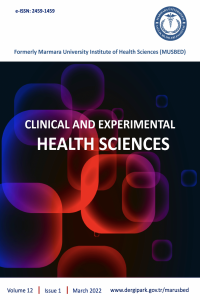Research Article
Issue Editorial Board

Feyza Arıcıoğlu was born on 1963 in Istanbul. She graduated from Istanbul University, Faculty of Pharmacy in 1986. Professor Arıcıoğlu started her career as a medical residency student at Istanbul University, Istanbul Faculty of Medicine, Department of Pharmacology and Clinical Pharmacology, completed her master's degree in 1988 and doctorate in 1993 at the same department, and received the titles of assistant professor in 1994, associate professor in 1998, and professor in 2004 at Marmara University, Faculty of Pharmacy, Department of Pharmacology. Concurrently, she served as visiting or faculty member at Cornell University, School of Medicine, Department of Neuroscience; University of Mississippi, School of Medicine, Department of Psychiatry; Temple University, School of Medicine, Department of Pharmacology, and Max-Planck Institute, Department of Psychiatry. Her main research area is neuropsychopharmacology. Professor Arıcıoğlu is the founding president of Psychopharmacology Research Unit (1996) within the body of Faculty of Pharmacy at Marmara University, the founder and chief editor of the Journal of Clinical and Experimental Health Sciences (2011-2015, 2018- ), and the academic editor of Psychiatry and Clinical Psychopharmacology (2020-) and Psychiatry and Behavioural Sciences (2020-). She currently is the Director of Institute of Health Sciences at Marmara University (2012-2015, 2018- ), the Ambassador to Turkey for the Organisation for PhD Education in Biomedicine and Health Sciences in the European System (ORPHEUS) (2013- ), and a Member of the Education Commission of the International College of Neuropsychopharmacology (CINP) (2016- ). Professor Arıcıoğlu has been serving as the Council Member of Turkish Higher Education of Quality Council (THEQC) representing CoHE, since January 2022.






In 2003, she became in Marmara University as an assistant professor and since 2003, she has been performing doctoral and later on postdoctoral research on oral medicine and oral radiology. In 2007, she is a guest researcher at the Section of DentoMaxilloFacial Radiology Department of Radiology, Sunderby Hospital in Lulea, Sweden. She became a professor in 2016. She served as a member of Congress Committee and Central Council, European Academy of DentoMaxillofacial Radiology in 2012. She has over 100 international and national publications on peer-reviewed journals. She is in the editorial and advisory board of some journals on her field.
Field of expertise: Oral medicine, oral cancer, oral radiology




Lisansını Erciyes Üniversitesi Sağlık Bilimleri Fakültesi Beslenme ve Diyetetik Bölümünden, yüksek lisansını Marmara Üniversitesi Sağlık Bilimleri Enstitüsü Halk Sağlığı Anabilim Dalından, Doktorasını Okan Üniversitesi Sağlık Bilimleri Enstitüsü Beslenme ve Diyetetik Anabilimdalı’nda tamamladıktan sonra 2020 yılında Doçentliğini almıştır. Çok iyi düzeyde İngilizceye ve orta düzeyde Fransızcaya sahiptir. İngilizce olarak yazılmış uluslararası yayınevleri tarafından basılan ‘Dietary Aprroaches To Irritable Bowel Syndrome(IBS)’ isminde kitabı mevcuttur. Ayrıca Ulusal yayınevi tarafından basılan birçok bilimsel kitaplarda bölüm yazarlığı vardır ve ayrıca editörlüğünü yaptığı bir adet ulusal yayınevi tarafından basılan çok yazarlı kitabı mevcuttur. Çok sayıda SCI, SCI-E, SSCI, AHCI ve alan indeksli ESCI tarafından taranan uluslararası yayını ve hakemli tr-dizin ve alan indeksli dergilerde yayınlanmış ulusal yayınları mevcuttur. Birçok Ulusal ve uluslarası kongre ve konferanslara konuşmacı ve katılımcı olarak katılmıştır.







 Web
Web

Aim & Scope
The aim of the journal is to contribute to the literature by publishing clinical and experimental research articles, case reports, letters to the editor, and and editorial comments prepared in accordance with the ethical guidelines in all disciplines of health sciences. The target audience of the journal includes specialists and medical professionals working in all disciplines of health sciences.
Clinical and Experimental Health Sciences (Clin Exp Health Sci) is an international, scientific, open access periodical published in accordance with independent, unbiased, and double-blinded peer-review principles. The journal is the official publication of Marmara University Health Sciences Institute and it is published four times a year on March, June, September and December. The journal publishes content in English. The journal publishes clinical and experimental research articles, review articles, case reports, letters to the editor, and editorial comments prepared in accordance with ethical guidelines in all disciplines of health sciences.
Author Guidelines
Clinical and Experimental Health Sciences (Clin Exp Health Sci) is an international, scientific, open access journal published in accordance with independent, unbiased and double-blinded peer-review principles. The journal is the official publication of Marmara University Institute of Health Sciences and it is published quarterly on March, June, September and December. The journal publishes clinical, experimental research and survey articles, review articles, case reports, letters to the editor and editorial comments prepared in accordance with ethical guidelines in all disciplines of health sciences.
Clin Exp Health Sci is indexed by the Emerging Sources Citation Index (ESCI) and the TR Dizin.
The journal publishes articles written in English. Clinical and Experimental Health Sciences aims to reach an international audience and will accept submissions from authors worldwide. It gives high priority to original studies of interest to clinicians and scientists in applied and basic health sciences.
The editorial and publication processes of the journal are shaped in accordance with the guidelines of International Committee of Medical Journal Editors (ICMJE), the World Association of Medical Editors (WAME), the Council of Science Editors (CSE), the Committee on Publication Ethics (COPE), the European Association of Science Editors (EASE), and National Information Standards Organization (NISO). The journal conforms to the Principles of Transparency and Best Practice in Scholarly Publishing (doaj.org/bestpractice).
Originality, high scientific quality, and citation potential are the most important criteria for manuscript acceptation. Manuscripts submitted for evaluation should not have been previously published or submitted for publication elsewhere.
Peer-Review Process
Manuscripts submitted to the journal will first go through a technical evaluation process where the editorial office will ensure that the manuscript has been prepared and submitted in accordance with the journal’s guidelines. Submissions that do not conform to the journal’s guidelines will be returned to the submitting author with technical correction requests.
Manuscripts passing the technical evaluation process will go through a double-blind peer-review process and will be reviewed by at least two external, independent peer reviewers who are experts in their fields. The Editor in Chief is the final authority in the decision-making process for all submissions.
Ethical Principles
An approval of research protocols by the Ethics Committee in accordance with international agreements (World Medical Association Declaration of Helsinki “Ethical Principles for Medical Research Involving Human Subjects,” amended in October 2013, www.wma.net) is required for experimental, clinical, drug studies and case reports. If required, ethics committee reports or an equivalent official document is to be provided by the authors. For manuscripts concerning experimental research on humans, a statement that shows the written informed consent from participants was obtained following a detailed explanation of the experimental procedures should be included in the text. Likewise, for studies carried out on animals an ethical committee report should be stated. Information on consents, the name of the ethics committee, and the ethics committee approval number should also be stated in the Methods section of the manuscript. It is the authors’ responsibility to carefully protect the participants’ anonymity. For photographs that may reveal the identity of the participants, signed releases of the participants or of their legal representative should be enclosed.
All authors are required to follow the privacy and informed consent from patients and study participants. Please confirm that any patient, service user, or participant (or that person’s parent or legal guardian) in any research, has given written consent on the inclusion to the study. The authors are responsible for the scientific content of the material to be published, and should complete and save the Patient Consent Form and send to the journal if requested.
Authorship
Each individual listed as an author should fulfill the authorship criteria suggested by the ICMJE authorship recommendations, which are;
1. Substantial contributions to the conception or design of the work; or the acquisition, analysis, or interpretation of data for the work
2. Drafting the work or revising it critically for important intellectual content
3. Final approval of the version to be published
4. Agreement to be accountable for all aspects of the work in ensuring that questions related to the accuracy or integrity of any part of the work are appropriately investigated and resolved.
All those designated as authors should meet all four criteria for authorship, and all who meet the four criteria should be identified as authors. Those who do not meet all four criteria should be acknowledged in the title page of the manuscript.
Similarity Check
Authors are requested to check their submissions for the presence and rate of similarity by a similarity detection software (eg. iThenticate by CrossCheck, intihal.net by TUBITAK). Only submissions with <20% similarity can proceed to the technical control and peer review stages. In the event of alleged or suspected research misconduct, e.g., plagiarism, citation manipulation, and data falsification/fabrication, the Editorial Board will follow and act in accordance with COPE guidelines.
Requested Forms
Clinical and Experimental Health Sciences requires corresponding authors to submit a signed and scanned version of the Authorship Contribution Form during the initial submission process in order to act appropriately on authorship rights and to prevent ghost or gift authorship.
Clinical and Experimental Health Sciences requires the authors to disclose any existing or potential conflicts of interests, including financial, any financial grants or other support received for a submitted study from individuals or institutions should be disclosed to the Editorial Board. To disclose above mentioned conflict of interests, Conflict of Interest Disclosure Form should be filled in and submitted. Cases of a potential conflict of interest of the editors, authors, or reviewers are resolved by the journal’s Editorial Board within the scope of COPE and ICMJE guidelines.
When submitting a manuscript to Clinical and Experimental Health Sciences, authors accept to assign the copyright of their manuscript to Marmara University Health Sciences Institute. If rejected for publication, the copyright of the manuscript will be assigned back to the authors. Clinical and Experimental Health Sciences requires each submission to be accompanied by a Copyright Transfer Form. When using previously published content, including figures, tables, or any other material in both print and electronic formats, authors must obtain permission from the copyright holder. Legal, financial and criminal liabilities in this regard belong to the author(s).
Before submission it is recommended for the authors to have the following documents ready for uploading separately: (1) Cover Letter; (2) Copyright Transfer Form; (3) Conflict of Interest Disclosure Form; (4) Authorship Contribution Form; (5) Similarity Report (iThenticate); (6) Ethics Approval Document
Statistical Analyses
Statistical analyses must be conducted in accordance with SAMPL guidelines for statistical reporting [T. A. Lang and D.G. Altman. Basic Statistical Reporting for Articles Published in Biomedical Journals: The “Statistical Analyses and Methods in the Published Literature” or The SAMPL Guidelines” in: Smart P, Maisonneuve H, Polderman A (eds). Science Editors’ Handbook, European Association of Science Editors, 2013].
Information on statistical analyses should be provided with a separate subheading under the Methods section. The strength of associations and confidence intervals should be indicated with exact p values (instead of stating as p <0.05). p values >0.05 should be reported with two decimal places; p values between 0.001 and 0.05 should be reported with three decimal places; p values shown on output as 0.000 should be reported as <0.001. p should be written in lowercase.
It is recommended for the authors to double check the accuracy of the information in the tables; eg. the percentages at a column or a row of a table should add up to 100.0%. Units should be in accordance with the International System of Units (SI).
Use a point (.) NOT a comma (,) as decimal separator (eg. 34.2%).
Research Articles: The main text of research articles should be structured in the sequence of Abstract, Keywords, Introduction, Methods, Results, Discussion, and Conclusion. ‘Aim of the study’ should be clearly indicated as the last paragraph of the Introduction section. Information on ‘ethics approval’ should be provided as the first paragraph of the Methods section. Please check Table 1 for the limitations for Research Articles.
Review Articles: Review articles prepared by authors who have extensive knowledge on a particular field and whose scientific background has been translated into a high volume of publications with a high citation potential are welcomed. Eminent authors may also be invited for their contribution with a review article by the editor of the journal. Reviews should describe, discuss, and evaluate the current level of knowledge of a topic in health sciences and should guide future studies. Review articles should be structured as follows: Abstract, Keywords, Introduction, Aim of the review, Methods, Results (body of the article structured by headings and subheadings), and Conclusion. Please check Table 1 for the limitations for Review Articles.
Case Reports: There is limited space for case reports in the journal and reports on rare cases or conditions that constitute challenges in diagnosis and treatment, those offering new therapies or revealing knowledge not included in the literature, and interesting and educative case reports are accepted for publication. The text should be structured as follows: Abstract, Introduction, Case Presentation, Discussion, and Conclusion. Please check Table 1 for the limitations for Case Reports.
Letters to the Editor: This type of manuscript discusses important parts, overlooked aspects, or lacking parts of a previously published article. Articles on subjects within the scope of the journal that might attract the readers’ attention, particularly educative cases, may also be submitted in the form of a ‘Letter to the Editor’. Readers can also present their comments on a published article in the form of a ‘Letter to the Editor’. Abstract, Keywords, and Tables, Figures, Images, and other media should not be included. The text should be unstructured. The article that is being commented on must be properly cited within this manuscript.
Editorial Comments: Editorial comments aim to provide a brief critical commentary by reviewers with expertise or with high reputation in the topic of the research article published in the journal. Authors are selected and invited by the journal to provide such comments. Abstract, Keywords, and Tables, Figures, Images, and other media are not included.
Table 1. Limitations for each manuscript type
|
Type of Manuscript |
Word Limit (Main Text Only) |
Abstract Word Limit |
Reference Limit |
Table Limit |
Figure Limit |
|
Research Article |
3500 |
250 (Structed) |
50 |
6 |
7 |
|
Review Article |
5000 |
250 (Structred) |
100 |
6 |
10 |
|
Case Report |
1000 |
200 |
15 |
1 |
7 |
|
Letter to the Editor |
500 |
N/A |
5 |
No tables |
No media |
MANUSCRIPT PREPARATION
The manuscripts should be prepared in accordance with ICMJE-Recommendations for the Conduct, Reporting, Editing, and Publication of Scholarly Work in Medical Journals (http://www.icmje.org/recommendations updated in December 2019). Authors are required to prepare manuscripts in accordance with the CONSORT guidelines for randomized research studies, STROBE guidelines for observational original research studies, STARD guidelines for studies on diagnostic accuracy, PRISMA guidelines for systematic reviews and meta-analysis, ARRIVE guidelines for experimental animal studies, and TREND guidelines for non-randomized evaluations of behavioral and public health interventions.
Ensure that your work is written in correct English before submission. We recommend that authors have their manuscripts checked by an English language native speaker before final submission. They may also get support from commercial English editing and proofreading services.
Manuscripts should be prepared in Word file format [A4 size; normal margins (top, bottom, right and left margins: 2.5 cm); Times New Roman; 12p; line spacing: 1.5; left-aligned; without left indent].
All the manuscripts should be submitted through the https://dergipark.org.tr/tr/pub/clinexphealthsci system. Manuscripts submitted via any other way will not be evaluated.
Organization of the Manuscript
Title page: A separate title page should be submitted with all submissions and this page should include:
- The full title of the manuscript as well as a short title (running title) of no more than 50 characters. Each word of the title and the short title should be capitalized.
- Name(s) and affiliations of the authors
- Grant information and detailed information on the other sources of support (if any)
- Name, address, mobile phone number and e-mail address of the corresponding author
- Acknowledgment of the individuals who contributed to the preparation of the manuscript but who do not fulfill the authorship criteria.
Abstract: Abstract should be submitted for research articles, review articles, short communications and case reports. No abstract is needed for letters, editorials and notes. The abstract of Research Articles and Review Articles should be structured with subheadings (Objective, Methods, Results, and Conclusion). The abstract of short communications and case reports should not be structured. Please check Table 1 below for word count specifications.
Keywords: Each submission must be accompanied by a minimum of three to a maximum of five keywords for subject indexing at the end of the abstract. The keywords should be listed in full without abbreviations. The keywords should be selected from the National Library of Medicine, Medical Subject Headings database (https://www.nlm.nih.gov/mesh/MBrowser.html).
Main Text: Main text includes the following:
- Title (The first letter of each word should be capitalized)
- Short title (Maximum 50 characters; the first letter of each word should be capitalized)
- Abstract (if needed): The heading “ABSTRACT” should be written in bold, capital letters. The subheadings “Objective, Methods, Results, Conclusion” should be written in bold letters; only the first letter of each word should be capitalized.
- Keywords (if needed): The heading “Keywords” should be written in bold letters; only the first letter should be capitalized. Only the first letter of the first keyword should be capitalized; each keyword should be separated by commas.
- Body of the text [eg. Introduction, Methods, Results, Discussion, Conclusion, Acknowledgment (in any), Funding, Conflicts of interest, References]: The headings “INTRODUCTION, METHODS, RESULTS, DISCUSSION, CONCLUSION, REFERENCES” should be written in bold, capital letters. The headings “Acknowledgment, Funding, Conflicts of interest” should be written in bold letters; only the first letter of each heading should be capitalized.
- Tables (if any)
- Figures (if any)
Section Headings and Subheadings
First-, second-, and third-order subheadings should be clearly distinguishable but not numbered.
The same level of heading or subheading should be of equal importance regardless of the number of subsections under it.
Section headings (eg. ABSTRACT, INTRODUCTION, METHODS, RESULTS, DISCUSSION, CONCLUSION, REFERENCES) should be written in bold, capital letters.
- First-Order Subheading: The subheading should be written in bold letters; the first letter of each word of the subheading should be capitalized.
- Second-Order Subheading: The subheading should be written in bold, italic letters; the first letter of each word of the subheading should be capitalized.
- Third-order subheading: The subheading should begin with a bullet point and be written in bold, italic letters; only the first letter of the subheading should be capitalized.
Tables
Tables should be included in the main document, presented after the reference list, and they should be numbered consecutively in the order they are referred within the main text. A descriptive title must be placed above the tables. Table titles should be written in italic and in sentence case (ie. capitalize the first letter of a sentence and leave all other letters as lowercase) [eg. Table 1. Adjusted all-cause and cause-specific mortality in 2001].
Abbreviations used in the tables should be defined below the tables by footnotes (even if they are defined within the main text). Tables should be created using the “insert table” command of the word processing software and they should be arranged clearly to provide easy reading. Data presented in the tables should not be a repetition of the data presented within the main text but should be supporting the main text.
Figures and Figure Legends
Figures, graphics, and photographs should be submitted as separate files (in TIFF or JPEG format) through the submission system. The files should not be embedded in a Word document or the main document. When there are figure subunits, the subunits should not be merged to form a single image. Each subunit should be submitted separately through the submission system. Images should be labeled (a, b, c, etc.) to indicate figure subunits. Thick and thin arrows, arrowheads, stars, asterisks, and similar marks can be used on the images to support figure legends. Any information within the images that may indicate an individual or institution should be blinded. The minimum resolution of each submitted figure should be 600 DPI. To prevent delays in the evaluation process, all submitted figures should be clear in resolution and large in size (minimum dimensions: 100×100 mm). Figure legends should be listed at the end of the main document.
All figures should be referred to within the main text, and they should be numbered consecutively in the order they are referred to within the main text. Figure legends should be written in italic and in sentence case (ie. capitalize the first letter of a sentence and leave all other letters as lowercase) [eg. Figure 1. Death rates by cause in 2001].
Acronyms and Abbreviations
All acronyms and abbreviations used in the manuscript should be defined at first use, both in the abstract and in the main text. The abbreviation should be provided in parentheses following the first time use of the definition.
When a drug, product, hardware, or software program is mentioned within the main text, product information, including the name of the product, the producer of the product, and city and the country of the company (including the state if in USA) should be provided in parentheses in the following format: “Discovery PET/CT scanner (General Electric, Milwaukee, WI, USA)”.
OTHER PARTS
Acknowledgements
Acknowledgements should be as brief as possible and placed in separate section after the conclusion, if any.
Funding
A funding statement should be inserted after the conclusion, with the header ‘Funding’, also if no special funding was obtained.
Conflict of interests
Conflicts of interest (also if there are none) should be stated in a separate section before the References.
REFERENCES
While citing publications, preference should be given to the latest, most up-to-date publications. Only the peer-reviewed articles (and proceeding abstracts) published in indexed journals can be cited as references. The cited references published in languages other than English can constitute at most 10% of all references. Theses cannot be cited as reference.
Only if an ahead-of-print publication is cited, the DOI number should be provided. Authors are responsible for the accuracy of references. Journal titles should be abbreviated in accordance with the journal abbreviations in Index Medicus/ MEDLINE/PubMed. All authors of the cited articles should be listed at the references section.
Number the citations consecutively according to the first mention of each source in the text (using the same number for subsequent references to the same source). The reference number should be given in round brackets before the punctuation. If more than one reference is cited for a statement, all of their numbers should be written in the round brackets separated with commas without any spaces. List the works cited, with corresponding numbers (without any brackets), on a new section after the text, titled REFERENCES. Please see the example below:
Operating room nurses have a significant role in ensuring and maintaining patient safety (1,2).
REFERENCES
1. Işık O, Akbolat M, Çetin M, Çimen M. The causes of medical error from the perspective of nurses. TAF Prev Med Bull 2012;11(4):421-430.
2. Akın Korhan E, Dilemek H, Mercan S, Uzelli Yilmaz D. Determination of attitudes of nurses in medical errors and related factors. Int J Caring Sci 2017;10(2):794-801.
The reference styles for different types of publications are presented in the following examples.
Journal Article: Altman DG, Gore SM, Gardner MJ, Pocock SJ. Statistical guidelines for contributors to medical journals. Br Med J 1983;7:1489-1493.
Book Section: Suh KN, Keystone JS. Malaria and babesiosis. Gorbach SL, Barlett JG, Blacklow NR, editors. Infectious Diseases. Philadelphia: Lippincott Williams; 2004.p.2290-2308.
Books: Sweetman SC. Martindale the Complete Drug Reference. 34th ed. London: Pharmaceutical Press; 2005.
Conference Proceedings: Bengisson S. Sothemin BG. Enforcement of data protection, privacy and security in medical informatics. In: Lun KC, Degoulet P, Piemme TE, Rienhoff O, editors. MEDINFO 92. Proceedings of the 7th World Congress on Medical Informatics; 1992 Sept 6-10; Geneva, Switzerland. Amsterdam: North-Holland; 1992. pp.1561-1565.
Scientific or Technical Report: Cusick M, Chew EY, Hoogwerf B, Agrón E, Wu L, Lindley A, et al. Early Treatment Diabetic Retinopathy Study Research Group. Risk factors for renal replacement therapy in the Early Treatment Diabetic Retinopathy Study (ETDRS), Early Treatment Diabetic Retinopathy Study Kidney Int: 2004. Report No: 26.
Epub Ahead of Print Articles: Cai L, Yeh BM, Westphalen AC, Roberts JP, Wang ZJ. Adult living donor liver imaging. Diagn Interv Radiol. 2016 Feb 24. doi: 10.5152/dir.2016.15323. [Epub ahead of print].
Manuscripts Published in Electronic Format: Morse SS. Factors in the emergence of infectious diseases. Emerg Infect Dis (serial online) 1995 Jan-Mar (cited 1996 June 5): 1(1): (24 screens). Available from: URL: http:/www.cdc.gov/ncidodlElD/cid.htm.
REVISIONS
When submitting a revised version of a paper, corresponding author must submit a detailed “Response to the reviewers” that states point by point how each issue raised by the reviewers has been covered and where it can be found (each reviewer’s comment, followed by the author’s reply and page and line numbers where the changes have been made) as well as an annotated copy of the main document. Revised manuscripts must be submitted within 15 days from the date of the decision letter. If the revised version of the manuscript is not submitted within the allocated time, the revision option may be canceled. If the submitting author(s) believe that additional time is required, they should request this extension before the initial 15-day period is over.
Accepted manuscripts are copy-edited for grammar, punctuation, and format. Once the publication process of a manuscript is completed, it is published online on the journal’s webpage as an ahead-of-print publication before it is included in its scheduled issue. A PDF proof of the accepted manuscript is sent to the corresponding author and their publication approval is requested within 2 days of their receipt of the proof.
Note: The abbreviated name of the journal is Clin Exp Health Sci.
Ethical Principles and Publication Policy
Ethical Responsibilities of the Publisher;
The publisher of the Journal of Clinical and Experimental Health Sciences is Marmara University Publisher, and is affiliated to the Marmara University Library and Documentation Department, which is a non-profit public institution. Clinical and Experimental Health Sciences journal is the scientific journal of Marmara University Institute of Health Sciences, covering all studies in the field of health sciences since 2011 and continues its publishing life successfully without compromising ethical principles. The journal is indexed in ESCI list.
Ethical Responsibilities of the Authors;
TR Index Journal Evaluation criteria were updated and the items related to the ethics committee approval, which required for scientific research were detailed. Therefore, the following criteria regarding ethics committee approvals will be sought / applied in the articles submitted to the Clinical and Experimental Health Sciences journal, which is mandatory for publications whose process started in 2020.
1. Researches requiring Ethics Committee approval are as follows;
• All kinds of research conducted with qualitative or quantitative approaches that require data collection from participants using questionnaire, interview, focus group study, observation and experimental techniques.
• Use of humans and animals (including material/data) for experimental or other scientific purposes,
• Clinical trials on humans,
• Research on animals,
• Retrospective studies in accordance with the personal data protection law.
Also,
• Stating that "Informed Consent Form" was obtained in case reports,
• Obtaining and indicating permission from the owners for the use of scales, questionnaires and photographs belonging to others,
• It should be stated that the copyright regulations are complied with for the intellectual and artistic works used.
2. Retrospective approval of the Ethics Committee is not required for the following studies: Using research data before 2020, produced from master's/doctoral studies (should be stated in the article), articles submitted for publication before 2020, accepted but not yet published.
3. It should be stated in the content of the article whether the ethics committee approval and/or legal/special permission is required in the submitted articles. According to the above information, if these permissions are required, it should be clearly stated in the article from which institution, when and with which decision number the permission was obtained.
4. If the research requires the use of human and animal subjects, it must be declared that the research was performed in accordance with international declaration, guidelines, etc.
5. Researchers who are not members of the university can apply to the local/regional Ethics Committees.
Ethical Responsibilities of the Reviewers;
• To accept the evaluation process of articles in the field of expertise that do not have conflict of interest.
• To consider only the content of the study in the evaluation of the article.
• To complete the article's review process on time.
• Commenting in a constructive language to help improve the quality of the article while requesting revisions.
• To protect the confidentiality of the information in and related to the article.
The Responsibilities of Editors, Associate Editor and Field Editors;
• Editors agree to meet the information needs of reviewers, authors, and readers as soon as possible.
• When making positive or negative decisions about articles, editors take into account the original value of the articles, their contribution to the field, the validity and reliability of the research method, the clarity of the expression, and the journal's purpose and scope.
• Editors implement the blind review and evaluation process, which are among the journal's publishing policies, and support the evaluation of unbiased and independent evaluations.
• Editors ensure the protection of personal data in the articles evaluated.
• Editors take care to protect human and animal rights in articles. They do not consider articles that do not have the ethics committee approval and, if necessary, permission documents for the study.
• Editors conduct or request originality-similarity checks on the content of the articles.
• Editors examine the applications or complaints sent to the journal and make the necessary explanations.
Failure to Comply with Ethical Principles;
In cases where there is a situation or behavior that does not comply with the ethical principles regarding the articles published in the Journal of Clinical and Experimental Health Sciences, editorial process, reviewers or authors, this should be sent to cehseditor@gmail.com.
